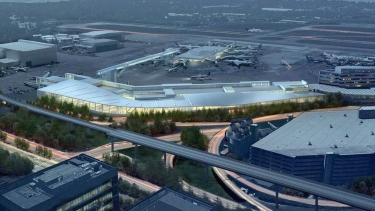|
Subscribe / Renew |
|
|
Contact Us |
|
| ► Subscribe to our Free Weekly Newsletter | |
| home | Welcome, sign in or click here to subscribe. | login |
Construction
| |
September 12, 2018
Port locks down budget for IAF at Sea-Tac: $968M
Journal Construction Editor
An independent review panel says the delayed and over-budget International Arrivals Facility at Sea-Tac Airport can be constructed for $773.9 million.
But in announcing that construction price yesterday, the Port of Seattle also released a new proposed total budget of $968.4 million. That's up $138 million from May, when the review panel was formed.
The completion date has also changed: it will be ready for testing on May 31, 2020 — eight months after the original date.
That overall budget also includes items such as $76 million in sales tax, $71 million in port management costs and $21 million in “port-furnished construction.”
The port and its progressive design-build contractor, Clark Construction, negotiated the $773.9 million guaranteed maximum price for construction and a completion date. Construction is about 20 percent done.
The panel cited the scope and complexity of the program, and the “supercharged” local construction market as the primary reasons for rising costs.
“We find that while the program cost is reasonable given the final design and current construction climate and the schedule achievable, both the port and contractor need to hit every mark to complete this complex program within the cost and schedule they have agreed to,” said panel leader John Okamoto in a news release.
The project has three main elements: a 450,000-square-foot grand hall for baggage claim and customs; an 85-foot-high aerial walkway to connect the South Satellite with the grand hall; and a sterile corridor for arriving international passengers on Concourse A.
The panel presented the report yesterday to the Port Commission, which will vote on the updated budget at its Sept. 25 meeting.
Here are some of the findings:
• Between December 2015 and April 2018 major elements were added, such as two additional aircraft gates on Concourse A and a basement baggage system that connects to the main terminal system.
• High demand in the area is raising costs for all contractors.
• The project is complex, with three new facilities and multiple system upgrades that have interdependent schedules and demands.
• Improvements are needed in port/contractor relationships and decision structures.
To improve decision making, port COO Dave Soike was recently put in charge of the project and consultant David Brush was removed from that job. Brush was picked because he worked on a project in San Diego that used the same contracting method.
Clark Construction also replaced its lead on the job — senior vice president Lou Palandrani — with vice president Brian Ahern.
Clark issued this statement yesterday: “Through an intensive and highly collaborative effort with the Port of Seattle over the past several months, we have reached a guaranteed maximum price and schedule for the IAF project, which we are confident we will meet. We appreciate the port's commitment of new senior leadership in recent months to support efforts to reach this significant milestone.“
The port hired RIB U.S. Cost to help validate subcontractor bids, and Analytical Management Solutions to analyze the proposed schedule, and they provided information to the panel.
The port will pay the panel up to $200,000. The work is done, but the port could reconvene the panel later.
Here are the panel members:
• Ken Johnson, president of Shiels Obletz Johnsen. Johnson managed design and engineering team for Seattle's central waterfront program, then served as project manager for the $400 million seawall project.
• John Okamoto, a government consultant and former Seattle City Council appointee and chief administrative officer at the Port of Seattle.
• Loren Smith, president of SmithConsult.Global. Smith has worked in global aviation and was involved in Sea-Tac's South Terminal expansion in the 1990s.
• Tina Millan, senior vice president and director of U.S. aviation services for WSP Florida. Millan specializes in large infrastructure programs.
The IAF is one of the first major construction projects in the state to use progressive design-build, in which construction begins while design is still underway, and the ultimate cost isn't known until the project reaches a certain point.
Port spokesman Perry Cooper said the process was expected to shave 18 months off the schedule versus the design-bid-build method, so he said it is still 10 months ahead in that scenario.
The IAF is expected to be ready for passengers in August 2020, after testing is finished.
The port says taxpayers aren't funding the project: money will come from airport-generated revenues, passenger facility charges and revenue bonds.
In addition to Clark, the project team includes Skidmore, Owings & Merrill, The Miller Hull Partnership, Arup, KPFF, MKA and Schlaich Bergermann Partner.
Benjamin Minnick can be
reached by email or by phone
at (206) 622-8272.



